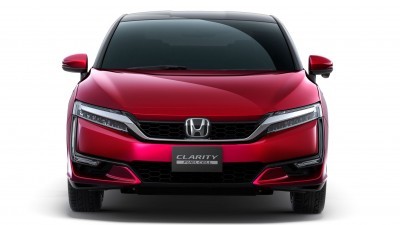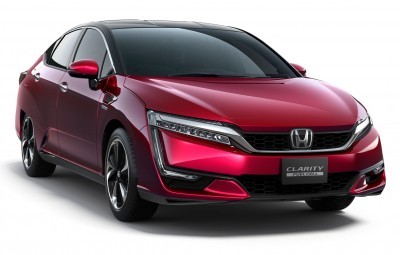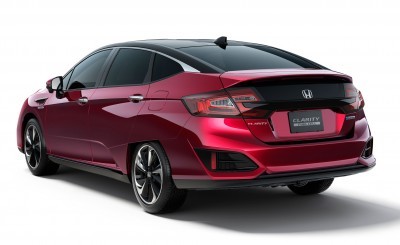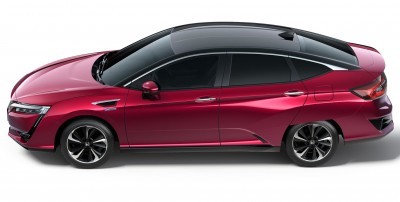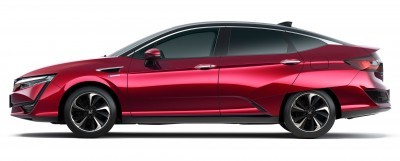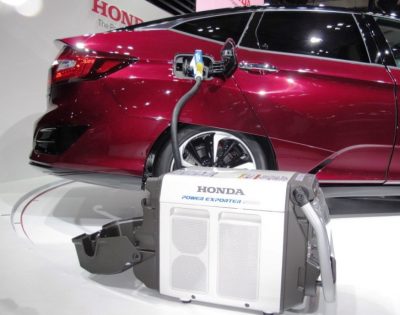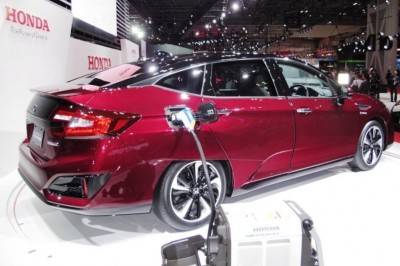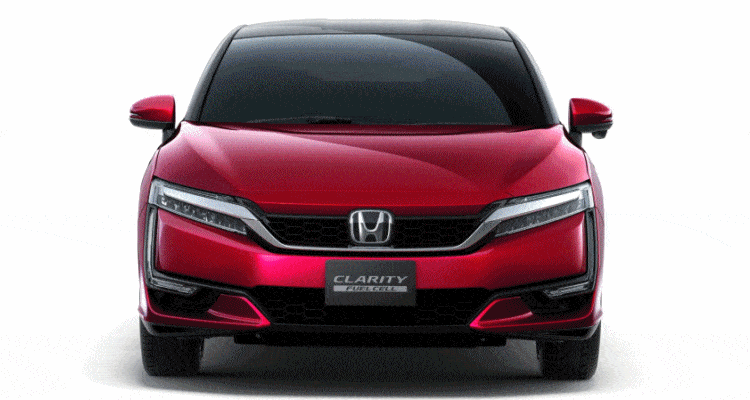 Honda has been working on hydrogen-fueled cars for several decades now, but hadn’t settled on a design they felt was worthy of releasing to the public until now. The Clarity Fuel Cell was just unveiled at the Tokyo Motor Show, and it packs an amazing punch, even though it looks like a standard four-door sedan.
Honda has been working on hydrogen-fueled cars for several decades now, but hadn’t settled on a design they felt was worthy of releasing to the public until now. The Clarity Fuel Cell was just unveiled at the Tokyo Motor Show, and it packs an amazing punch, even though it looks like a standard four-door sedan.
It Emits Only Water
Hydrogen fuel cell vehicles are so clean that the only thing that flows from the tailpipe is water. The cars rely on basic chemistry to convert hydrogen into power. The hydrogen enters the chamber, and is introduced to an anode. Its protons pass through a membrane, while the elections are funneled through a conductive circuit. The power that’s generated is stored in a lithium ion battery, and the hydrogen particles meet with oxygen at the end, forming water.
Honda is Refining the Process
Although Honda has been working on hydrogen-fueled cars since the 1980s, they weren’t the first ones to release one to the public. Toyota beat them to it with the release of the Mirai, but the manufacturer was unable to overcome one of the biggest problems. Fuel cell stacks are usually incredibly large, even bigger than a standard V6 engine, which means the Mirai couldn’t squeeze it under the hood. Instead, designers built it into the center of the car’s cabin, snatching away valuable real estate from passengers. Honda’s engineers, on the other hand, managed to shrink the fuel cell stack by one-third, so the company was able to put it under the hood. This means it resembles a standard gasoline-fueled car, and can seat up to five passengers. While it may not seem like a big deal, this is the first time an auto manufacturer has managed this feat.
The Fuel Cell is Strong Enough to Power a House for Seven Days
Even though the fuel cell stack is smaller, it’s also incredibly powerful. It boasts an output of 100 kW, and the Clarity’s electric engine has a maximum output of 130 kW. It blows away the Mirai in terms of refueling needs by about 50 miles as well, going approximately 434 miles between fill-ups. Honda took the concept one step further, and also created a device called the Power Exporter 9000. When the Clarity Fuel Cell is hooked up to it, it can power an average-sized home for about a week. While it’s unlikely that Americans will be plugging their vehicle’s fuel cell stacks in at home as a power source, it’s worth noting that the company’s estimate of a week of power was based on Japanese consumption. State-side, it’s likely to last about half as long.
Honda is Working on Refueling Options
Obviously, refueling stations are going to be an issue when the Clarity starts to hit the streets. According to the U. S. Department of Energy, there are only 12 non-private hydrogen fuel stations in the whole country. Ten of the stations are in California, which means anyone outside of the state’s boundaries is pretty much out of luck. The two other stations are located in South Carolina and Connecticut, limiting drivers in those stations to just one fueling option each. Supposedly, dozens more were expected to be built by the end of 2016, though there’s no word on how the development projects are going. Because of this, the automaker is working on creating personal refueling stations, which drivers can install at home.
The Cars Will Go on Sale in March 2016
Initially, Honda will release the vehicles in Japan, followed by Europe, and then America. The starting price is 7.66 million yen, or just under $63,000, though the company plans to lease the first batch only to businesses and municipalities. It’s believed that this decision is largely the result of logistics in relation to refueling options, as cities and business fleets often have their own refueling stations on site.
At this point, we don’t know if the price will stay as it is now, or what the cost of personal fueling stations will be. Both will largely determine the success of Honda’s venture. In any case, the new vehicle is nothing short of revolutionary, and may well be what helps hydrogen-fueled cars go mainstream. For now, all eyes will be on Japan, watching how the cars fare with consumers there.
Author Bio: Jamie Hanninen, Digital Marketing Manager at The Boyd Group and Gerber Collision.
Honda Exhibits World Premiere of CLARITY FUEL CELL, Planned Production Model of its All-new Fuel Cell Vehicle, at 44th Tokyo Motor Show 2015
— Lease sales in Japan will begin in March 2016 —
Key specifications
| Number of occupants | 5 |
| Cruising range (reference) | More than 700km*4 (Honda internal measurement while being driven in JC 08 Mode |
| Refueling time | Approximately 3 minutes*5 |
| FC maximum output | More than 100kW |
| FC stack output density | 3.1kW/L*1 |
| Motor maximum output | 130kW |
| Hydrogen maximum filling pressure | 70MPa |
| Energy storage | Lithium-ion battery |
| Vehicle size (length X width X height) | 4,895mm x 1,875mm x 1,475mm |
| Price*6 (reference) | 7.66 million yen (including consumption tax) |
- Body color (total 3 colors)
‐Premium Brilliant Garnet Metallic (Roof color: Black / Interior color: Platinum Gray)
‐While Orchid Pearl (Roof color: Black / Interior color: Platinum Gray)
‐Crystal Black Pearl (Interior color: Platinum Gray)
Power Exporter photo thanks: GreenCarReports


